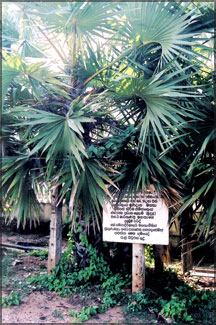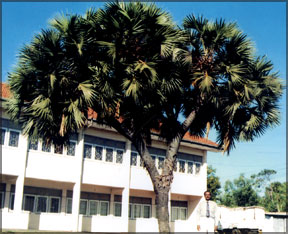Propagation and preservation of The branched palmyra tree
S. T. Markandu
The tree reaches a height of 20 feet. It is
believed that it takes15-20 years for all the fourteen branches to
appear if secured from the damage of cattle and goat initially for about
five to seven years of its growth and watered at regular interval.
A rare variety of Palmyra tree is found in Batticaloa town in
clusters here and there and around the Weber stadium on the way to the
Fort where the Kachcheri is located. Also it is found in two places near
the Vallipuram Vishnu Temple, in Point Pedro, Jaffna. This Palmyra tree
(Scientific Name: Hyphaenu thebaica) is believed to have its origin from
a foreign country. It is said that it might have been introduced by the
Dutch or the British, most probably by the Christian Missionaries during
the early period of the British Rule. It gives an enchanting view to the
eye and could also serve as a tourist attraction. It is mostly an exotic
plant.
Growth Habit:
|

Tender plant at Vavuniya Kachcheri Circuit Bungalow. |
Although this tree is a palm, it has the peculiar habit of branching.
Its trunk is like a Palmyra tree. From the trunk two branches appear and
each branch divides in to two ultimately ending up with fourteen
branches, apart from the main trunk.
The tree reaches a height of 20 feet. It is believed that it takes
15-20 years for all the fourteen branches to appear if secured from the
damage of cattle and goat initially for about five to seven years of its
growth and watered at regular interval.
It is a very hardy plant and suitable for marginal areas. However, it
exhibits a rapid growth in fertile soil and in areas where more rain is
experienced.
Fruit:
Fruits are borne in branches. Each bunch may have 20-50 fruits. Each
fruit contains only one seed which differs from the local Palmyra fruit
which in most cases contains three seeds. As the fruit matures its
colour turns to mixed red and yellow.
The fruits can be eaten. The skin of the fruit has to be removed by
knife or by biting it. Then the flesh of the fruit can be eaten. Unlike
the ordinary Palmyra fruit, the flesh is not juicy. The flesh is not
sweet, neither bitter or sour. It has its own taste.
Seeds:
These seeds are not planted in beds to obtain the Jaffna Farmers
famous "Kottai Kilangu" as the root of this plant does not store much
starch and is thin, thus it has no value.
Toddy Tapping:
No one has tried tapping for toddy or treacle which may have to be
explored in future.
Planting:
|

Tree planted in memory of Cumaratunga Munidasa planted by K.
Sabapathypillai of Trincomalee. |
a. The seedlings can be planted along the highways, parks and
beaches. The seedlings should be planted in rows at 10 feet distance and
a pacing between rows can be at 6-10 feet. Also it could be planted i a
wide circle to form a clusters where by shade could be obtained to rest
under them.
b. To facilitate growth, the bottom leaves should be cut.
Leaving a minimum of 5 tender leaves, the bottom leaves should be cut
every other year, contrast to the coconut palm where bottom leaves
should not be cut and tied together. It is possible to cut the leave to
a height of 5-10 feet when they are young. As the plant grows higher and
higher, it is not possible to climb the tree to cut the leaves as the
sides of the stalks will not allow. But as years pass by, the matured
stalks of the dried leaves will start dropping. It is only after that it
becomes possible to climb the tree. If one would like to climb above a
certain height then one has to cut the stalks. But it is not that easy
to cut as the stalks are hard as steel.
Raising of Seedlings:
a. The fallen ripe fruits or very matured fruits plucked from
the trees are collected and kept under shady trees or covered by coconut
or Palmyra leaves and the like or covered by cadjans to prevent the
seeds from being exposed to sun and heat so that the germination will
not be affected.
b. The matured fruits could be identified by the colour of the
outer skin. It must be yellowish red.
c. To quicken the process of germination the seeds may be kept
in water for not more than a month.
d. Raised beds or ridge are made of soil preferably sand? The
soil must be loose. Any soft soil is ideal. When the soil is loose, it
will enable the sprouts to penetrate in to it without obstruction and
damage. The loose soil will prevent curling of the sprouts. The required
number of beds may be raised by 6' X 2' X 4' - 5' depending on the
number of seeds to be germinated.
|

New Secretariat Batticaloa |
e. The seeds are placed in rows. The beds need to be covered
with coconut leaves to prevent sun light affecting the germination. If
the beds are under shady trees, they need not be covered.
f. The seeds will sprout soon in about a month after laid on
the bed/ridge. By lifting the seeds one can observe whether it has
sprouted. Once the sprouts appear it can be placed in the polythene
bags.
g. The polythene bags of size 2' - 3" X 4" are filled with
sand or loose soil, up to a height of 2'.About ten holes are to be made
at the bottom of each polythene bag to enable excess water to seep out.
The sprouts are to be carefully placed on the soil in the bag. The
sprouts should not be damaged or broken. To keep the sprout safe make a
hole on the soil and keep the sprouted seed over it and cover the area
with some sand. At least 3" area to be kept unfilled to pour water. The
bags are to be kept in rows. It must be seen that they do not fall upon
each other.
h. Watering should be done once in 4-5 days. Care should be
taken not to over-water as excess watering leads to decaying of seeds
with sprouts. Due to heavy rains the sprouts may be affected. It is
advised to keep them under a covered shed.
i. Leaves may appear within 1-2 months. There should be tree
leaves before transplanting. It is the most suitable stage to transplant
the seedling with three tender leaves.
j. The ground has to be prepared for transplanting the
seedlings. The depth of the pit is to be little more than the height of
the polythene bag. It must be 2' - 4" X 6". Before placing the bag in to
the pit, some loose soil must be put in as the bottom is hard, to enable
the root to penetrate down. When placing the bag, the tender leaves must
be slightly above the ground.
k. During transplanting one should not forget to remove the
polythene bag. After placing the bag in the pit, the bottom of the bag
must be cut round and removed and the pit is filled and the upper
porting of the bag could be pulled over and removed. Rain water should
not stagnate till the roots have firmly rooted.
l. Securing the plant is also necessary to grow the plants. As
many branches spread, an area of 6' X 4' may be fenced right round the
plant. Goats or cows should not eat the leaves. No damage shall be
caused to the tender leaves during the stage of the growth of the plant
for 5 to 7 years.
Importance of Planting the Branched Palmyra Tree:
a. The main purpose is to save this palm tree from extinction.
It is to be pointed out here that recently on hearing that the CEB
officials in Batticaloa were cutting down the branches of this palm
trees, the elders and youth in the surrounding area rushed to the scene
and protested vehemently which led to abandon the operation.
|

Planted along Telecom Road off Inner Harbour Road in
Trincomalee. |
b. So in planting the seedlings one should pre-plan and plant
them at a distance away from telephone or electric wires or underground
cables or foundation of buildings and drains.
c. A survey should be carried out annually to assess the
number of plants survived and appropriate action to be taken to fill the
vacancies and take remedial action to protect them.
d. If interested the Palmyra Development Board, Environment
Authority, Forest Department, Coast Conservation Authority, Road
Development Authority, Road Development Department of Provincial
Councils and the Local Authorities such as Municipal Councils, Urban
Councils, and the Provincial Councils could propagate the cultivation of
this tree and save it from extinction as they are in a position to
contribute a lot to achieve the objective.
e. P. Veluppillai, Retired Senior Officer of the Rural
Development Department and Assistant Director Rural development, NEP of
Saravandi Street, Kallady, Batticaloa and his son V. Kamalendran have
practical knowledge and experience in raising nurseries. They raised
nurseries on small scale for the NE Provincial Ministry of Agriculture,
Lands and Irrigation for distribution. As they are pioneers in this
field, their advice and services could be obtained.
f. Let us save the Branched Palmyra tree from extinction'
'Let us provide basic facilities to plant and grow trees'
'Let us ensure they grow and survive'
'Let us contribute towards environment development'
'Think of the Future Generation and Grow Trees'
'Plant Trees even at the expense of losing your time, energy and
money for the good of the future'
'Plant, protect and grow useful trees in memory of your forefathers
and respected men of learning'
'Where there is water and land plant anything useful for the benefit
of the mankind'
'What is required is Action and Institutional support and
Coordination
'Let us plant plants to prevent soil erosion and heavy winds'.
'Let us plant for food'
'Let us educate our children on the value and virtues of planting'
'Let us plant for fire - wood and energy"
The writer : Former Secretary, Ministry of Agriculture,
Livestock Development, Land, Irrigation & Fisheries, North East
Provinces
|

